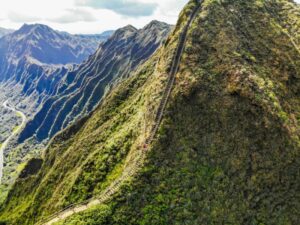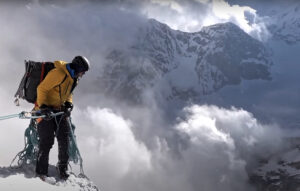Things are not looking good on Rakaposhi for the three climbers stranded in bad weather at 6,900m.
Helicopter pilots tried to approach the mountain twice today. Thick clouds forced them back the first time. Then winds near 60kph forced them to abort. The two helicopters are back in Gilgit and will try again tomorrow.
However, not even the excellent pilots of the Pakistan army can reach Jakub Vlcek, Peter Macek, and Wajidullah Nagri while they are in Camp 3. That lies well above the helicopters’ flying roof. Most of the rescue will fall on Abdul Joshi, the professional climber from Shimshal, who summited Annapurna with Sirbaz Khan last spring. He has volunteered to help, but he cannot do it alone. Local climber Karim Shah Nizari is in contact with Joshi and shared the details with ExplorersWeb.
Climbers unable to descend
Vlcek (spelled Vicek in some reports), Macek, and Nagri are relatively safe in their C3 tent. They are in good health and have food for two more days. They might have some frostbite and are facing their fifth night at altitude.
Vleck’s home team reported that the climbers set off from Camp 3 toward the summit of Rakaposhi early on September 8. They reached the top rather late in the day. At 5 pm, Nagri texted home to say that they had just started descending. They reached C3 as the weather worsened. They have not moved since.

The stranded climbers’ location on the British SW Spur route.
According to Karim Shah Nizari, the trio climbed the British SW Spur route from the Kunti Glacier. But they didn’t fix ropes all the way up, and therein lies the problem.
“The climbers can’t descend any further because the section right below them has no fixed ropes,” Nizari said. “Abdul Joshi [the rescuer] is a strong and technically sound climber, but he can’t perform miracles. He needs a good and strong group of people with him. The route is very long and they’ll need to fix rope on their way. Without fixed ropes, rescue is impossible.”
Nizari estimates that rescuers will need 400m of rope to fix the missing sections. They also need more climbers to assist Joshi — climbers who are acclimatized enough to reach 6,900m and can fix ropes and conduct a high-altitude rescue.
Some local people from Shimshal have bravely volunteered to help, but they lack the necessary skills and they have no rope. However, Karim Hayat, another climber from the Hunza Valley, has since volunteered to join.
“Whoever goes there will need at least two days on the mountain, fixing ropes, breaking trail up the ridge, and then will have to rescue three people,” Karim Shah said.

Climbers’ C3 location. Map: Karim Shah Nizari
Right now, Joshi is waiting at the Nagar Valley. Weather permitting, the helicopter will pick him tomorrow and drop him as high up as possible. It is not clear where that will be, since the route follows a steep ridge. From that point, it will be up to him.
Request for teams in the area
Nizari believes that Joshi will need a team already in Pakistan, and well-acclimatized. Currently, the strong Polish team of Janusz Golab, Adam Bielecki, and three younger climbers are in the area, “but they may not be acclimatized yet,” Karim said. “The other option is the Georgian team that summited Saraghrar in Chitral, two days ago.”
In fact, news is still expected from the three Saraghrar summiters, Archil Badriashvili, Baqar Gelashvili, and Giorgi Tepnadze. They should have reached Base Camp today but have not checked in yet.
“Right now, only Czech authorities can arrange such a petition,” Nizari said. “The embassy might contact these expeditions’ alpine associations and request help.
Finally, Nizari had some tough words for the Rakaposhi climbers. They ventured up the mountain with no climbing permit (confirmed by Pakistan Alpine Club’s secretary Karrar Haidri) and no NOC (a No Objection Certificate, as confirmed by Gilgit-Baltistan authorities).
“They just went up in a crazy way,” Nizari said. “That’s not a sensible way to climb.”
At least, the climbers had insurance coverage, according to Haidri. The insurance company would have contacted a local agent in order to launch the rescue.






